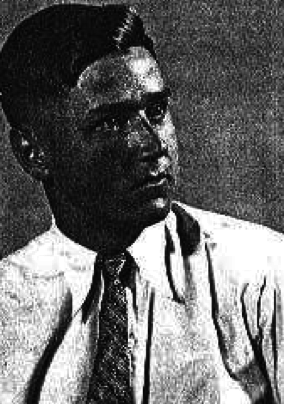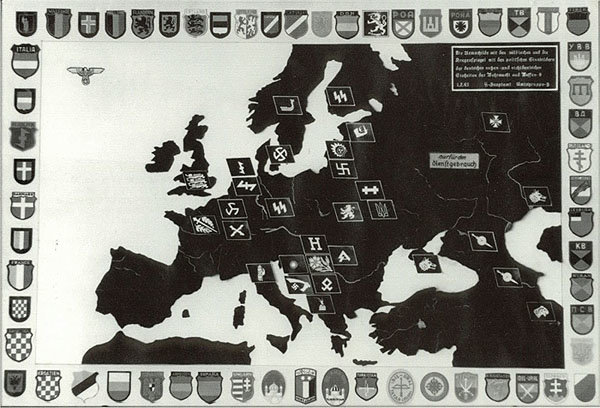The European Union is now considered to be the standard of democracy, liberalism and human rights. Yet even though everything might be in order with the component of liberalism, and there might even be an excess of this phenomenon, there is clearly a lack of democracy. The structure of decision-making in the European Union is complicated and lacks mechanisms which hold the top leaders of the EU accountable to nations.
The European Parliament, the only democratic institution of the union, has only an advisory status and is therefore not a real legislature. In fact, the ordeal of European integration is in the hands of only a narrow circle of people. Moreover, this feature is inherent to the system ever since the beginning of the post-war process of European integration. On the eve of the EU referendum, British media has even revealed an important fact concerning the EU's past which explains a lot about its present:
the process of EU integration, from the outset, was coordinated by the CIA to create an anti-Russian geopolitical bloc in Europe.But the CIA did not build the European Union from scratch.
The most important contributions were made earlier by the Nazis. From a geopolitical point of view, the Third Reich, with its occupied countries of Europe and satellite states, represented a version of "united Europe." Many Nazi achievements were later used by the Americans, which determined the aggressive anti-national and anti-Russian character of the modern European Union.
German historians have repeatedly published the Nazis' documents containing plans for European integration. Gerhardt Haas and Wolfgang Schumann's collection of documents was released in 1972 in East Berlin, titled
The Anatomy of Aggression: New documents concerning the military goals of German imperialism during the Second World War. This book primarily cited evidence of large-scale plans for the economic integration of Europe under the Nazi leadership in the interest of European financial capital. In particular, such plans were hatched in the Reich Ministry of Economics, the Reich Industrial Group, and the Reich Ministry of Foreign Affairs. Another German collection of documents on the relationship between the Third Reich and the process of European integration was released in West Germany in Munich in 1987. It was called Europe and the Third Reich and was composed by Hans Werner Neulen. It paid special attention to the political plans of the Nazi leadership to unify Europe. In 1985, Michael Zalewski, published the first volume of Documents the history of European integration, titled Plans for a Continental European Union: 1939-1945. It is not difficult to guess what kind of integration was at stake.
Historians have noted that such linguistic constructions as "European Union", "European Economic Community", and "European Confederation" which fill European media were first announced as official elements of state policy in the documents of the Third Reich.
The European integration of the SS
Alexander Dolezalek
One of the main developers of "united Europe" was the SS officer Alexander Dolezalek who headed an SS department specifically created for this. After World War II Dolezalek worked for the special services of Western Germany and the United States under the name of Alexander Bomhoff and headed the "All-European educational project" (Gesamteuropäischen Studienwerk) in the German town of Vlotho .
His works on European integration after the war were thoroughly studied by leading theorists in this domain and had an impact on the speech of Winston Churchill in Zurich in 1946, when the former British prime minister appealed to create a United States of Europe. Some aspects of the Schuman Declaration, which began the history of the modern EU, especially in terms of the integration project as a means of ensuring lasting peace in Europe, can be found in Dolezalek's earlier plans.
To his credit, the Nazi officer's plans to transform Europe at least included a declaratory preservation of the identity of the peoples of the western part of the continent, something which the EU does not even humor now. At the same time, in other parts of the SS on the other hand, plans for the consistent Germanization of conquered Europe were elaborated. In particular, there were plans for totally implementing the German language as obligatory and forming a homogeneous information space. This question was given priority by the famous German linguist in the SS-Ahnenerbe.
Other of Dolezalek's plans sound quite modern now and in fact fully coincide with the policy of the current European elites. In particular, Dolezalek proposed to eliminate the borders between European countries and introduce a single European passport. East Europeans, like now, were treated as second class humans. The SS planned to redraw the ethnic borders within Eastern Europe in order to avoid cause for conflict in the future. However, the activities of the SS for creating a "United Europe", as we have seen, were not limited to the person of Dolezalek.
On March 1st, 1945 another SS officer, Hans Schneider, was instructed to undertake the development of the topic of "European organizing ideas." Schneider, who worked for the "Ancestors Heritage" institute (Ahnenerbe), soon disappeared, only to reappear after the war with documents bearing the new name of Hans Schwertke and settle in the publishing house "Stalling", which was engaged in the propaganda of the "European idea" and European integration. Interestingly enough,"Stalling" simultaneously hired some former officers of the SD: Hans Reossner and Wilhelm Spengler.
The organization declaratively adhered to left-liberal ideology but, significantly enough, their post-war European integration propaganda involved the same people that it did during the Nazi dictatorship. From a geopolitical point of view, they tried to recreate the unity achieved by German weapons on new grounds, and restore Europe as a geopolitical entity. The United States, in turn, hoped to manipulate the anti-communist convictions of the former Nazis and their achievements in order to oppose united Europe to Russia as was done on the eve of the Second World War. In both cases, the Atlanticists relied on the same forces.

European SS map
The Ministry of Foreign Affairs of the Third Reich also worked on the draft for a "United Europe" Together with the SS, Ribbentrop's Office paid special attention to this issue after the defeat at Stalingrad. It became necessary to propose an idea which could mobilize the population of European countries against the growing might of the Soviet Union. Goebbels' Propaganda Office then issued a communique which called for actively pursuing "a new European image of German foreign policy." Established in 1942, the new "European Committee" within the Reich Foreign Ministry began active work. On March 21st, 1943, Ribbentrop sent a memorandum to Hitler in which he stated the need for a "European Confederation." The composition of this new political entity was supposed to include Germany, Italy, France, Denmark, Norway, Finland, Slovakia, Hungary, Romania, Bulgaria, Croatia, Serbia, Greece and Spain.
A memorandum of the Ministry of Foreign Affairs of Germany from September 9th, 1943 reveals the structure of the future European Confederation.
This proposed structure does not differ significantly at all from the current structure of the EU. Economic issues were to be governed by the European Economic Council, and it was suggested that a European Monetary Union and European Central Bank be created. All of these ideas were later implemented in the European Union in a liberal format.The European Economic Community and the beginning of European integrationAnother term, "European Economic Community", was also used for the first time and elaborated in detail in Nazi documents for plans to integrate the economic space of European countries as developed by the economic departments of the Reich. The leading theorist on this matter was Werner Deitz, the head of the Society for European Economic Planning and Great Space Economics. Nazi economic theorists planned to establish a uniform planning and management system for the European economy which would steadily erode the economic sovereignty of states. At the same time, the political sovereignty of states in this system was supposed to be replaced by the "sovereignty of the people" which in practice led to the destruction of the independence of traditional European nation-states, as is the case in the current EU.
The economic departments of the Reich understood European integration as a process in which all the other nations of Europe were to promote the development of the German economy. At the same time, although sharing this idea, some German economists elaborated a more differentiated approach. As Secretary of State of the Imperial Ministry of Economy and SS officer Gustaw Schlotterer advocated, the process of European unification on an economic basis in German interests could begin with linking national economies. This concept later became the basis for the contemporary process of European integration. The Schlotterer Commission also drew up plans for a future European bank to be based in Vienna.
It is noteworthy that the current European Union grew out of the European Coal and Steel Community. The same German steel and coal industrialists of the Ruhr in Germany supported the Schlotterer plan and then in 1951 initiated a new association. In Düsseldorf, in the center of the Rhine-Ruhr region, Shlotterer found work after de-Nazification as an economist at the enterprises of the steel industry.
Given the Nazis' active work on creation of the European Union, it is not surprising that, for example, Walter Hallstein, the first president of the Commission of the European Economic Community, one of the founding fathers of the European Union, and the father of European Law in the 1930's and '40's, was a member of the National Socialist Union of Jurists. Moreover he openly used the same phrases and logical constructions regarding new European law after the Second War II as he did during the Hitler regime for discussing new juridical systems for occupied territories.
Of course, plans for the unification of Europe existed before the Second World War.
The Nazis did not invent anything new, but it was their organizational efforts and advocacy activities that helped demonstrate that United Europe is not a myth, but an implementable political and economic project. Their achievements formed the basis for European integration in its liberal version just as former Nazis became the post-war advocates of the "European idea." The same German industrialists that led the Nazis to power (the Tyssen and Krupp families) later initiated the creation of the European Coal and Steel Community.Undoubtedly, Europe should become a new pole of a multipolar world. However, the birth marks of European integration associated with the inheritance of the Nazi project cause fear as to the future of the European countries in this structure. The Nazi legacy was absorbed by the liberal EU mainly because of the common rationalistic basis of the Enlightenment. This legacy includes:
- Hyper-centralism in the economic and political spheres, which leads to the infringement of the national sovereignty of member states.
- Aiming to eliminate the national state sovereignty Europe
- The unification of Europe by a single ideological standard (Nazi or liberal) and the submission of national interests to this abstract idea (whether Nazi or liberal)
- A basically undemocratic nature of European institutions, which are accountable to the financial and industrial elite, not the people of European countries
- The exploitation of weak peripheral countries (Greece, Eastern Europe) by Western European powers, especially Germany
- Anti-Russian geopolitical orientation.
See also ‘The Madrid Circular’ document from the 1950s which set forth plans for post-war German domination of a unified, Nazified Europe by economic and financial means. Discussion here:
Germany Plots with the Kremlin by T. H. Tetens
[Link]
And Madrid Circular discussion by meticulous researcher/author Joseph P. Farrell in his recent book “The Third Way: The Nazi International, European Union, and Corporate Fascism” (on Amazon). Fascinating reading ... he brings it right up to date.